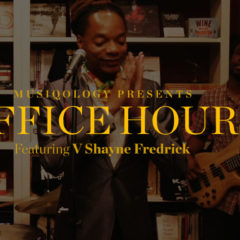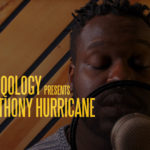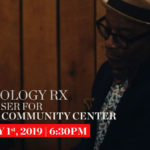Nothing New is MusiQology’s latest recurring series. Written by Penn PhD candidate Ben DuPriest, this collection of essays debates the utility and danger of proclaiming music “new” (or “old”) within a larger historical and political frame. With a focus on contemporary recordings labeled “jazz” for a variety of reasons, DuPriest unpacks the politics of that label and an ongoing debate over the utility of new-ness.
Marcus Strickland’s 2016 album Nihil Novi was released as a collaboration between Blue Note Records and Revive Music. True to its name, the Revive music project stresses a commitment to ‘reviving’ jazz by exploring its intersection with other styles. While Strickland’s diverse stylistic approach to composition and performance exemplifies this initiative, his rhetorical response to generic categorization pushes back. A proponent of Nicholas Payton’s post-jazz “Black American Music” moniker, Strickland often avoids the jazz label altogether, claiming (or seeking) a “genre-less” ethos. His music sounds firmly “jazz,” though, while borrowing and dabbling heavily around the edges (and at times far afield) of the genre. Ultimately, we might suggest that it’s something else entirely—maybe more pan-, or trans-generic. The thing he’s “reviving” might be something harder to pin down.
The Revive Music label imprint is a recent partnership between Blue Note Records and the New York-based Revive Music organization. Revive was originally a live music agency “that specialized in producing genre-bending, creative-concept live music shows that toured worldwide with the purpose of educating and inspiring audiences about artistic and authentic forms of music.” Revive describes itself as an “advocacy platform” for musicians, but the line between “advocacy” and “publicity” is (productively) blurry.
In recent years, Revive began two high-profile collaborations: The first was with OkayPlayer.com, titling and producing its jazz-focused blog, revive-music.com, which “advocates” (again, read: publicizes) like-minded, genre-bending jazz artists. The second collaboration is as the vanity subsidiary that put out Strickland’s album; a Revive insignia is branded alongside the iconic Blue Note oval on a handful of its most cutting edge artists’ albums. Blue Note Revive received some attention for earlier releases, including a stellar 2014 compilation entitled “Supreme Sonacy Vol. 1” which carried an explicit statement of purpose, exemplifying the organization’s larger ethos:
“‘Sonacy’ is an undefined derivative of sound where the lines between genres are blurred,” the site reads, tipping the scales from liner notes to press release. “It takes place where the heart, mind and soul come together and meet to breathe new dimensions and possibilities for musicians and listeners alike. Marching past commonplace conventions into newfound territory, Sonacy harkens to the supreme, transcendent common denominator that every musical tradition shares. It is the aesthetic and its creators who have been at the heart of REVIVE’s mission for almost a decade.”
As some critics have stated, these words are probably best served with a grain or two of salt. For one thing, such generic transcendence directed towards the effort of “reviving” the music is not necessarily a novel or exceptional idea, nor is the very basis and rhetoric of revivalism undeserving of at least a dash of salty skepticism. Furthermore, Revive has all the agency here—they’re the ones who’ve dictated the “commonplace”-ness of conventions, setting up a dichotomy where they’re effectively disrupting genre organizations that were ex post facto constructions in the first place.
But in the end, more effective than the organization’s press-release-cum-call-to-arms, though, are the exciting musics this collaboration has produced, particularly Strickland’s recent release. Despite Strickland’s implicit suggestions otherwise, Nihil Novi is indeed a practice in genre-crossing. Each track reveals a specific assemblage of stylistic facility concocted and composed by Strickland, performed by his band “twi-life,” and mediated and crafted by producer-mastermind Meshell Ndegeocello, whom Strickland claims as perhaps his most important inspiration. “Meshell is genre-less,” Strickland explains on the Blue Note site. “She goes by who she is as a person. And that’s exactly what I’m doing. I’m not interested in affixing myself to a particular genre; I want to express who I am musically as a person.”
Although his music is not as much of a hip-hop-jazz mashup as Robert Glasper’s (who appears on the album…because he’s everywhere), Strickland has said that his most significant musical influence on this project was the late producer J-Dilla, likening his compositional process on Nihil Novi to “DJ culture,” or the ways in which hip hop beats and backing tracks are constructed. The album is not predominated by programmed beats, though, nor are there many explicit correlations with Dilla’s style (although some have likened the organ sounds and behind-the-beat snare hits to Dilla—see Stickland’s “Cycle” for yourself), but it isn’t hard to see how the rhythms and textures, as well as the ways in which Strickland seems to approach the compositional process, are inspired by these production methods. This is particularly clear as the music unfurls in the live take for the official video for “Drive;” percussive texture is constructed piece by piece, as if being built out of a collection of samples and overdubs.
The album’s sonic evocations don’t stop at Dilla or hip-hop, though. Multiple tracks, particularly the final cut, “Mirrors,” clearly reference the Afro-beat sounds of Fela Kuti; “Sissoko’s Voyage” is an allusion to the Malian Kora player Bazoumana Sissoko, whose music is primarily paid homage through Ndegeocello’s melodic bass playing; “Mingus” is a stylistic tribute to the canonic bassist-composer, in whose big band Strickland played, and whose sound looms large throughout the album. There’s a network of sorts here, where the transgressive dabblings are only rendered so by outside forces. There is also a healthy dose of gospel, R&B, and soul; and perhaps most unpredictably, the track “Talking Loud” employs harmonic ideas that Strickland borrows from Hungarian composer Bela Bartok’s “15 Hungarian Peasant Songs.” In fact, he lists Bartok’s approach to harmony as a general compositional influence.
The list could go on, but the truth is, with a few exceptions, Strickland’s album tends to fit more neatly into what the jazz listening public probably expects out of a new release, even at times flirting dangerously with the incriminating sounds of “smooth jazz.” It’s a less radical statement of Revive’s “sonacy” than some of the organization’s other releases, but the extent to which listeners may think the music does or does not “revive” or “revolutionize” jazz doesn’t really matter. What’s more, whether listeners think the songs sound like Dilla, Fela, Bartok, or anything else, is neither here nor there. Far be it from us to compromise Strickland’s agency to claim inspiration. The album is a well-constructed new musical statement, but it articulates faithful awareness of jazz’s relation to its musical other, as well as its own past, present, and future.

 Share On Facebook
Share On Facebook Tweet It
Tweet It








